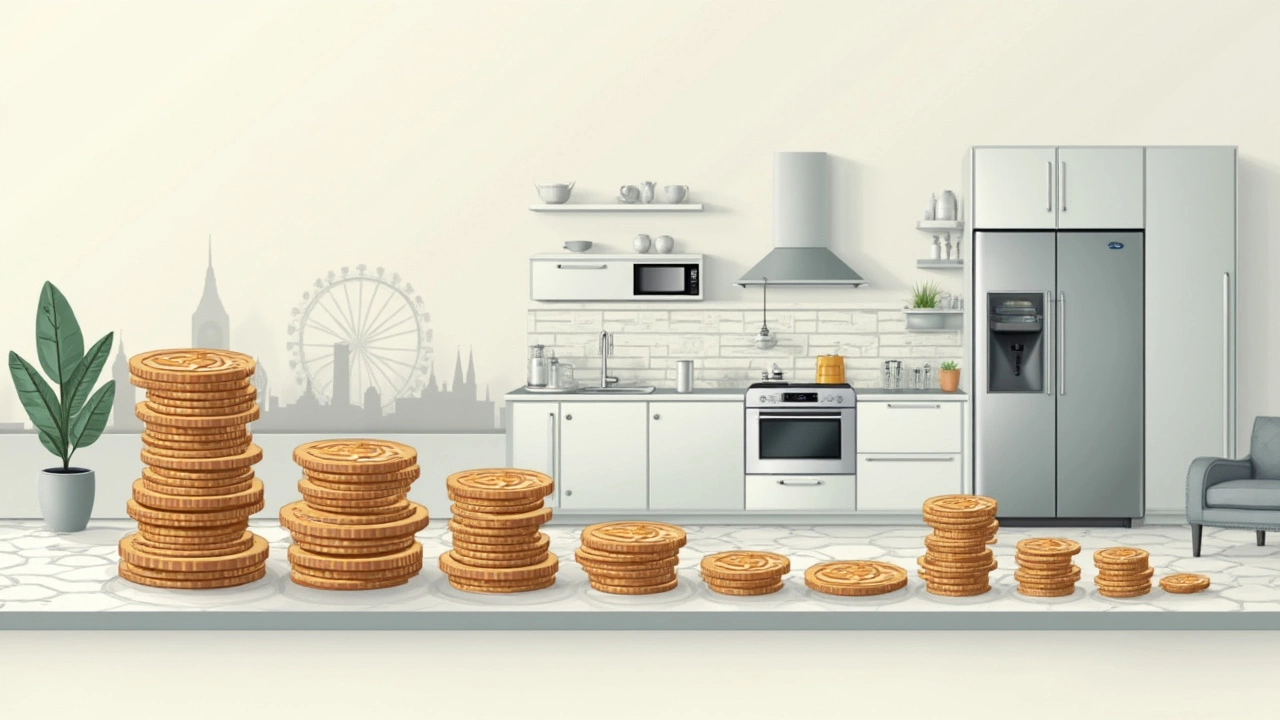If you’ve ever looked into redoing a kitchen, you probably noticed that the bills stack up fast. But where does most of your money actually go? Most people are surprised to learn just how lopsided the spending can get.
The biggest slice of the kitchen remodel pie almost always goes to the cabinets. Seriously. Cabinets can eat up anywhere from 25% to 40% of the total budget. The cost balloons if you want custom work, fancy storage solutions, or real wood instead of particleboard. It’s not just the wood and finishes—soft-close hinges, pull-outs, and organizers drive the price way higher than you'd expect.
Knowing this up front helps you figure out where to save and where to spend. If cabinets aren’t your top priority, there are smart ways to cut costs without gutting your whole plan or ending up with a flimsy setup. Want some tips for that? Stick around—you don't need to compromise on quality to get a kitchen you'll actually love.
- Why Kitchen Remodels Cost So Much
- Cabinetry: The Top Expense
- Countertops and Their Surprising Price
- Appliances: Worth the Splurge?
- Hidden Costs Homeowners Miss
- Smart Ways to Trim Your Budget
Why Kitchen Remodels Cost So Much
Nothing eats up a home improvement budget quite like tearing apart and rebuilding the kitchen. You're not just switching out a few things—nearly every part of the room gets touched, and everything from materials to labor adds up fast. The kitchen is where you blend durability with looks, and that combo bumps up the cost quick.
Here’s why those numbers get so high:
- Kitchen remodel projects bundle a ton of tradespeople: carpenters, plumbers, electricians, tile setters, and more. Each one handles a piece, from wiring for lighting to making sure your sink drains right. This isn’t a job for one general handyman.
- Materials matter. Even something simple like swapping laminate countertops for quartz or granite can cost hundreds—or thousands—more.
- Appliances are pricier than ever, and most folks upgrade them during a remodel. Think energy-efficient fridges, new ovens, and those sleek dishwashers with all the buttons.
- Code updates and hidden surprises, like old wiring or water damage behind the walls, add unexpected costs nobody likes to find after demo day.
Check out how an average kitchen remodel bill typically breaks down, according to the National Kitchen and Bath Association in 2024:
| Category | Percentage of Total Cost |
|---|---|
| Cabinetry & Hardware | 29% |
| Installation | 17% |
| Appliances | 14% |
| Countertops | 10% |
| Flooring | 7% |
| Lighting | 5% |
| Walls & Ceilings | 5% |
| Design Fees | 4% |
| Doors & Windows | 4% |
| Other (plumbing, outlets, misc.) | 5% |
If you thought it was just about buying shiny new stuff, think again. You’re paying for expertise, materials, and peace of mind that nothing’s going to fall apart or fail a home inspection. The little stuff, like hardware and design fees, might seem small, but added together, they’re a real chunk of the budget.
Cabinetry: The Top Expense
Cabinets are easily the costliest part of a kitchen remodel. Most people don’t realize how quickly the numbers add up—especially for bigger kitchens or anyone wanting something beyond builder-basic looks. National averages in 2025 put cabinetry costs anywhere from $8,000 to $20,000, and that’s for mid-range options. Custom cabinetry? That price tag can hit $30,000 and up, especially if you go for real wood, trendy finishes, or built-in organizational add-ons.
Why do cabinets get so expensive? It mostly comes down to materials, doors, and how they’re made. Solid hardwood options like maple, cherry, or walnut are much pricier than particleboard or MDF. Full overlay or inset cabinet doors (where gaps are practically invisible) always cost more. And if you toss in pull-out shelves, soft-close hinges, or lazy Susans, those features drive up the final bill faster than you might expect.
Most installers will tell you cabinets set the tone for the whole kitchen. They’re in every line of sight, and any flaws are easy to spot. That’s why a lot of folks bite the bullet and pay up for quality, even if it means cutting back elsewhere.
If you want to save some dough but aren’t ready to live with old, creaky cabinets, here are some smart approaches:
- Consider refacing instead of replacing—keep the bones, just swap out the doors and drawer fronts for a big style change at a fraction of the cost.
- Skip custom sizing if your layout can work with standard cabinets. Stock or semi-custom units can look awesome once they’re installed.
- If you really want new but need to save money, go flat-pack and assemble yourself—think IKEA or similar. But budget extra time and patience for the build.
One sneaky cost most homeowners miss: the installation. Custom cabinets or weirdly shaped kitchens mean more labor, which tacks on extra hours for the crew. Always ask for detailed quotes before you sign off on anything.
Countertops and Their Surprising Price
Most people picture cabinets swallowing their kitchen budget, but countertops can be shockingly pricey too. Even the big-box stores know this—just walk down the countertop aisle and compare price tags. While laminate used to be the standard, most remodels today chase the look and feel of stone, and that’s where costs jump.
Let’s break down average prices for the usual suspects:
| Material | Average Cost per Sq. Ft. | Why People Like It |
|---|---|---|
| Laminate | $20 - $50 | Budget-friendly, tons of colors |
| Granite | $50 - $100 | Strong, unique patterns, classic feel |
| Quartz | $60 - $120 | Non-porous, low maintenance |
| Marble | $70 - $200 | Luxurious look, unique veining |
| Solid Surface | $50 - $125 | Seamless, easy repairs |
Now, here’s the kicker—installation usually costs almost as much as the material itself. Many stone slabs are heavy and tricky to handle. If your kitchen has a weird shape or you want fancy edge details, labor costs can spike fast. For a standard remodel, kitchen remodel jobs often dedicate 10% to 15% of the total budget to countertops alone.
If you’re on a tight budget but want that stone look, consider quartz remnants or butcher block for part of the project. It’s common for homeowners to mix materials—granite on the island, but laminate around the perimeter. Don’t be afraid of “off-brand” stones either—sometimes the look is identical, and nobody will notice except your wallet.
Looking out for hidden charges? Ask about template fees, cutouts for sinks, and backsplash add-ons. These extras aren’t always obvious up front but can make your total jump hundreds or even thousands of dollars.

Appliances: Worth the Splurge?
It’s easy to get pulled in by those shiny, pro-grade ranges and built-in espresso makers, but is splurging on appliances actually worth it? The truth: it totally depends on your cooking habits, how long you plan to stay in your house, and what you expect from your kitchen.
Appliances for a kitchen remodel can swing wildly in price, based on brand name, size, features, finishes, and whether you go for built-in or freestanding models. Here’s what’s typical for major appliances as of early 2025:
| Appliance | Low-End | Mid-Range | High-End |
|---|---|---|---|
| Refrigerator | $700 | $2,000 | $10,000+ |
| Range/Oven | $600 | $2,500 | $12,000+ |
| Dishwasher | $400 | $1,000 | $2,500+ |
| Microwave | $200 | $500 | $1,200 |
High-end brands like Sub-Zero, Wolf, and Miele get a ton of hype, but studies show that the average kitchen remodel spends about $7,500 total on appliances for a mid-range upgrade. For luxury kitchens, that number jumps well above $15,000.
So, why spend big? Some high-end appliances have practical perks: pro ranges heat faster and more evenly, refrigerators offer better food preservation, and smart tech lets you preheat the oven or check the fridge from your phone. If you really cook all the time or host big gatherings, these features can save time and hassles. On the flipside, if you’re the takeout type, pouring money into restaurant-grade gear might not pay off.
- Always read user reviews instead of just going by brand. Some mid-range options punch way above their weight.
- Energy-efficient models might cost more up front but save money on bills over time.
- Builders and designers say that, resale-wise, mid- and high-end appliances help homes sell faster—but don’t always raise the selling price as much as people hope.
Bottom line? Pick appliances to match your lifestyle rather than for show. Invest in what you’ll actually use every day. Sometimes, a solid mid-range model ends up being the smartest buy.
Hidden Costs Homeowners Miss
When you think about a kitchen remodel, you’re probably picturing countertops, cabinets, and shiny new appliances. But there’s a long list of hidden costs that catch people off guard—they can add thousands to your final bill.
The most common surprise? Moving plumbing and electrical lines. Installing an island with a sink or swapping the oven’s spot can mean calling in extra pros to reroute pipes and wires. Then there’s the cost of permits. Some towns charge a flat fee, but others base it on the size or value of your remodel. It’s easy to forget this step, but skipping a permit can cost you much more if there’s an inspection hiccup down the road.
Demolition brings its own set of budget-busters. Open up a wall and you might find water damage, old wiring, or even mold that’s got to go. Fixing these isn’t optional, and these repairs almost always run over the initial estimate. Here are some other overlooked costs homeowners regularly run into:
- Hauling away old cabinets, appliances, and debris
- Upgrading the electrical panel to meet code for new appliances
- Asbestos or lead paint removal in older homes
- New lighting and outlets nobody included in the original plan
Here’s a quick table to show just how these small things add up for the average American kitchen remodel:
| Hidden Cost | Average Price Range (USD) |
|---|---|
| Plumbing/Electrical Relocation | $1,000 - $5,000 |
| Permits | $300 - $2,000 |
| Asbestos/Lead Removal | $500 - $3,500 |
| Unplanned Repairs (water, wiring, etc.) | $500 - $4,000 |
| Waste Removal/Dumpster Fees | $250 - $900 |
Want a tip? Ask your contractor—before the job starts—if they’ve budgeted for these line items. Some pros underbid on purpose, knowing hidden costs give them room to up the total. It’s smart to add about 10%–20% of your budget as a cushion, just for these "uh-oh" moments. That slack can save you from serious stress later.
Smart Ways to Trim Your Budget
Remodeling a kitchen can get expensive fast, but you don’t have to throw money at every part of it. There are straightforward ways to keep your costs in check and still end up with a space you love. These hacks aren’t just for penny-pinchers—they’re legit options most pros recommend to save a chunk of change.
- Cabinets are usually the priciest part, so look here first for savings. If your cabinets are in good shape, consider painting or refacing instead of ripping everything out. That move alone can cut your cabinetry costs by more than half. Also, stock cabinets from big-box stores are a fraction of the price of custom builds and still look stylish when installed right.
- Want fancy countertops but can’t stand the sticker shock? Mix materials. Use a pricier stone like granite or quartz on that statement island, but go for durable laminate or butcher block on the side counters. This combo looks intentional and saves a ton.
- Skip the high-end appliance package unless you seriously need extra features. Standard brands these days make solid, energy-efficient ovens and fridges for a lot less than luxury names. Check for last year’s floor models and sales, too. You can save hundreds, if not thousands, just by timing your buy.
- Handle some of the easier work yourself. Tasks like painting, installing hardware, or swapping out light fixtures don’t usually need a pro. Even if you’re not super handy, there are good videos for just about everything now.
- Don’t forget about unused materials. Lots of towns have building material reuse centers—think Habitat for Humanity’s ReStores—full of brand new or gently used finds: sinks, tile, cabinets, even lighting. One kitchen’s leftovers might be your perfect fit at a huge discount.
- Finally, always keep wiggle room in your budget for the surprise stuff. Most remodels run into things you won’t see coming, like hidden water damage or funky wiring. The rule of thumb: set aside 10 to 20% of your total budget just for surprises, so your whole plan doesn’t fall apart over one random hiccup.
Being smart with where you splurge and where you save isn’t about cutting corners—it’s about making your money work harder in your kitchen remodel. You’ll end up loving the results way more if you know you didn’t overspend where it counts.





